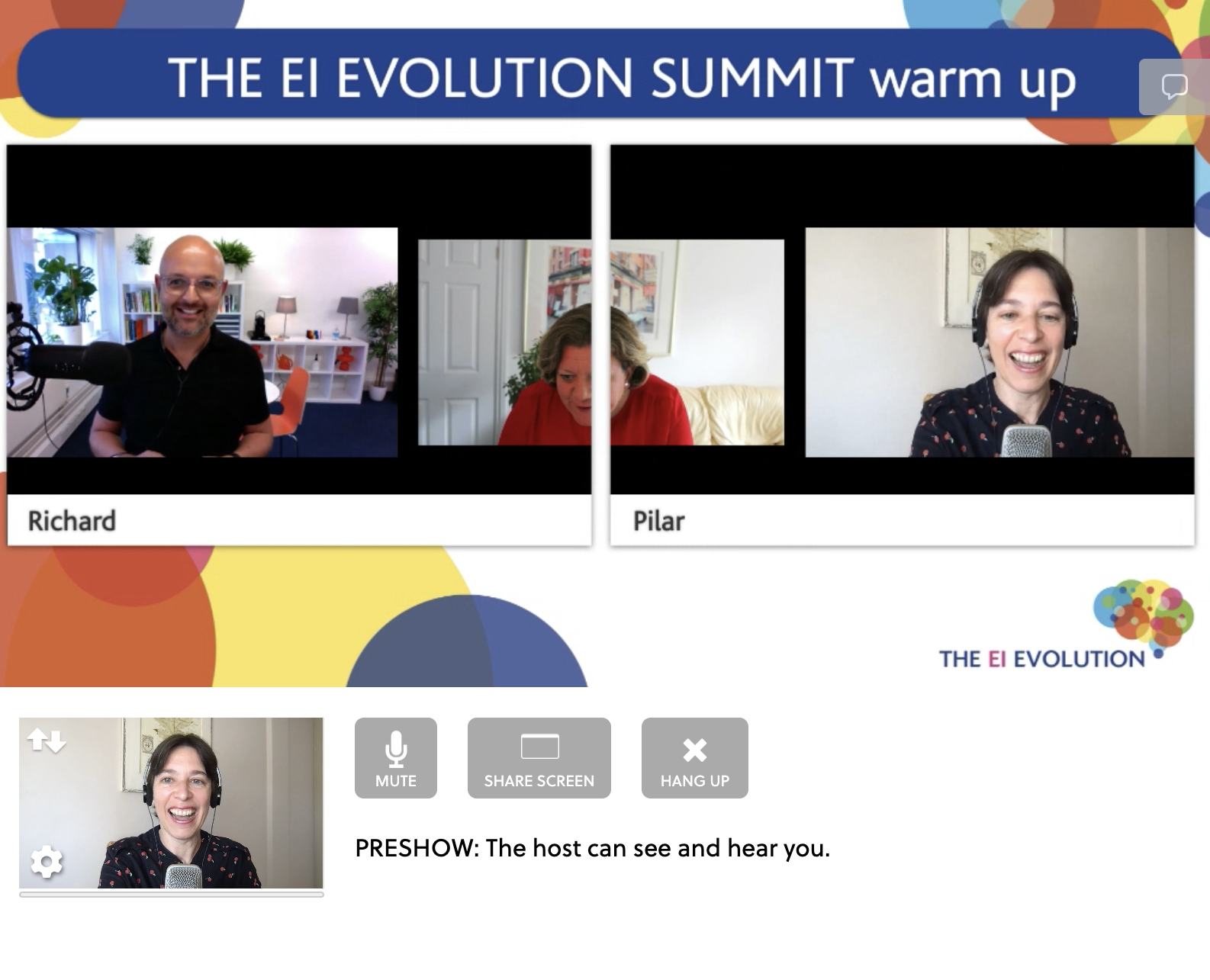WLP283: Beyond the #watercooler - Loneliness in Remote Teams
Today’s episode brings a live conversation between Pilar and her podcasting partner Richard Mackinnon, about the role of emotional intelligence in tackling loneliness and disconnection in remote teams.
Pilar did a live talk with Dr Richard MacKinnon on loneliness and disconnection in remote teams back in July, as part of the Learning Lounge of the Emotional Intelligence (EI) Evolution.
Sandra Thompson
The live EI Evolution event is on October 12th, featuring the godfather of EI Daniel Goleman - you can learn more and book here, using code PILARORTI10 for a 10% discount. Sandra Thompson is hosting the event, she's the first Goleman Emotional Intelligence Coach in the UK (you can hear her and Rowena Hennigan in episode 248.)
Meanwhile here’s the conversation between Pilar and Richard (who regularly podcast together on the My Pocket Psych show, if you want more), with input from Sandra and live listener questions.
Beyond the #watercooler
The #watercooler channel in online collaboration has often represented social connection and a way to overcome loneliness, by deliberately creating space to communicate about non-work things. It’s been around since before the pandemic and enforced remote working, so we must remember that there is an element of before and after/during going on here, and acknowledge the confounding role of lockdown in cutting off everyday face-to-face social interactions even for long-term remote workers.
Richard MacKinnon
Disentangling loneliness and disconnection is also interesting. It’s possible to feel disconnected from colleagues, but not at all lonely, or the other way around, and it’s dangerously easy to use our own experience as a yardstick for imagining how others should feel.
Loneliness can exist in any workplace or group setting, and one definition is distress caused by a lack of perceived quality relationships.
Importantly, this is about our own perception, which depends on self awareness and knowing what we need/seek from our interpersonal relationships. It has a high impact on our well-being if these needs are not met. Another definition suggests it’s about the gap between actual and desired levels of social connectedness, which again highlights the perceptual nature of it, the way it depends on what we actually expect in the first place - which will be different for each individual.
How do managers/organisations help with overcoming a gap, which is a unique internal need for each individual?
Some way of talking about needs and expectations within the team is essential, as well as noticing the signs of deficiencies in individual wellbeing - in the same way that stress can be identified and addressed, managers have a responsibility for doing this, whatever the stigma, because loneliness is so damaging and detrimental. Normalising the subject in everyday conversation is a good start.
Again like stress, finding ways to manage and compare levels of loneliness - and how people feel about the quality of their workplace connections - is a good way to monitor any changes or deterioration over time.
19.14 Self awareness
Identifying the gap between what you need and what you have is part of the emotional intelligence toolkit for the effective remote worker, as is finding ways to meet those needs creatively and flexibly (which may be outside the workplace). “Weak tie” events can be enough to make us feel connected, little touchpoints in the community, rather than deep intense conversations. It’s important for each of us to connect with our own needs, then figure out how to meet them, across the spectrum of our potential for interactions with other people.
However, Richard points out that as a species/society we could generally do with better emotional literacy, that is, the ability to identify and distinguish and correctly attribute our own emotions. So many people cannot distinguish hunger from thirst, never mind evaluate the source of complex underlying anxiety or malaise. Events like a pandemic can create so many interrelated emotions, it’s very difficult to unpick and understand how this impacts our behaviour.
And that’s our own emotions - well before we attempt to work out and address what’s going on for somebody else!
Extroversion and introversion are often invoked when trying to understand other people’s social needs, but remember the individual subjectivism when it comes to loneliness - introverts and extroverts can both feel lonely due to a lack of depth in their interactions whatever role their personality plays, and it’s important to avoid stereotyping and generalising.
27. 44 Remote vs. colocated work
When it comes to the workplace, we need to remember all of the above - and not assume we know what people are getting out of their various connections and interpersonal relationships, whether these are taking place on or offline. In remote teams we do need to be more proactive, and more aware of the risks of assuming ‘I’m OK so everyone else is probably OK’, or not.
If we don’t directly ask people how they are, they probably won’t tell us. It’s easier to hide emotions online and become withdrawn, while still remaining professionally productive at least for a while. It adds levels of complexity when we have forced/lockdown-related home working to consider, and not all the well-intentioned online social things that 2020 brought us were a success.
Managers may need training and emotional equipment to initiate these conversations, and to meet their own needs in the first place - so they can understand what’s going on for their colleagues, and how to best support them.
34.30 talking about emotions
Sandra mentioned how simple tools can help, like a deck of cards with words about feelings on them (like the emotional culture deck) which can trigger in-depth conversations, giving people permission to unlock those words and express the vulnerability that talking about emotions can bring.
Richard frequently uses Acceptance and Commitment Theory (ACT) to help people choose how to show up, and create a little distance from their emotions - which might help overcome discomforts in anticipated situations (like talking to your manager about how lonely you feel, for example).
But all these conversations take time, and can easily get overlooked, if they’re not prioritised by managers. Especially when we’re in an emergency situation - which is where emotions are most likely to affect things.
Managers (and peers), can open and hold space for others to talk about emotions. Sharing links and information about disconnection and its dangers, research about emotions, might be a starting point - to signal that this stuff is taken seriously in the team, so it’s OK to talk about, or just to show people that what they’re feeling might not be so uncommon. Brief social/non-work-related chats help to continuously build trust, so managers can model and encourage this through their own behaviour.
With remote teams in particular, these interactions deepen our knowledge of each other as whole interesting humans, instead of single-dimension online connections. We can’t (and should not try to) replicate the colocated space, but we can focus on elements which offer similar benefits.
We should also acknowledge the value of talking about the work, and the depth of connection this can bring, in online collaboration. If people care about the work, it's important to them, then making space for these conversations around it help to build relationship too.
This is why many people enjoy coworking environments, where there can be deep professional connections formed, whether with colleagues or peers. But we need to be conscious about boundaries, our own and those of others - recognising that our own need to chat and connect at work might overstep what others require, and once again it all comes back to intentionality and deliberateness, in our communications. This will help overcome misunderstandings and feelings of rejection.
Using the right tools can also help enhance perceptions of closeness, such as seeing a colleague’s avatar pop up in a shared document - providing touches of interaction in a very simple and passive way. Usually this means consciously using the tools we already have in a better way and more intentionally - rather than having to add/use something else. Technology is neutral, humans bring the emotion! But tech can also help us bridge gaps of both physical distance, as well as silos between teams and hierarchies… letting us find our work buddies wherever they are, IF we make the effort to seek them out.
Sandra brought up the role of humour, and how this can identify connections and break down barriers, as well as how this helps identify unexpected commonalities in how you think or what makes you smile. However humour is not universal and is easy to misconstrue as well, and can surface misunderstandings or lack of shared context, especially across different generations and cultures.
All of this forms part of our developing remote collaborator professional skill set, which is well worth consciously cultivating, starting by attending to our own emotional literacy and self awareness. We must also never forget that the experiences of the past 18 months are NOT typical of how it feels, to work on a distributed/remote team.
A glimpse of backstage…
Richard and Pilar are working on a brand-new workshop for managers on this theme, to help acquire and practice the skills needed to overcome all these challenges - so make sure you’re on our mailing list (see below) to receive further news about that soon - or get in touch now. And meanwhile, our new Podcasting for Connection service can help you too, with strengthening those ties between people in your organisation.
Do contact us, or you can tweet Virtual Not Distant, or Pilar directly, with your thoughts and ideas and feedback.
If you like the podcast, you'll love our monthly round-up of inspirational content and ideas:
(AND right now you’ll get our brilliant new guide to leading through visible teamwork when you subscribe!)




